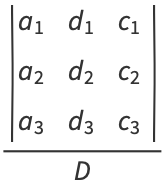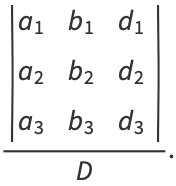UTeM BMFR Google Search Engine

Given a set of linear equations
 | (1) |
consider the determinant
 | (2) |
Now multiply ![]() by
by ![]() , and use the property of determinants that multiplication by a constant is equivalent to multiplication of each entry in a single column by that constant, so
, and use the property of determinants that multiplication by a constant is equivalent to multiplication of each entry in a single column by that constant, so
 | (3) |
Another property of determinants enables us to add a constant times any column to any column and obtain the same determinant, so add ![]() times column 2 and
times column 2 and ![]() times column 3 to column 1,
times column 3 to column 1,
 | (4) |
If ![]() , then (4) reduces to
, then (4) reduces to ![]() , so the system has nondegenerate solutions (i.e., solutions other than (0, 0, 0)) only if
, so the system has nondegenerate solutions (i.e., solutions other than (0, 0, 0)) only if ![]() (in which case there is a family of solutions). If
(in which case there is a family of solutions). If ![]() and
and ![]() , the system has no unique solution. If instead
, the system has no unique solution. If instead ![]() and
and ![]() , then solutions are given by
, then solutions are given by
 | (5) |
and similarly for
 | (6) | ||
 | (7) |
This procedure can be generalized to a set of ![]() equations so, given a system of
equations so, given a system of ![]() linear equations
linear equations
![[a_(11) a_(12) ... a_(1n); | | ... |; a_(n1) a_(n2) ... a_(nn)][x_1; |; x_n]=[d_1; |; d_n],](http://mathworld.wolfram.com/images/equations/CramersRule/NumberedEquation6.gif) | (8) |
let
 | (9) |
If ![]() , then nondegenerate solutions exist only if
, then nondegenerate solutions exist only if ![]() . If
. If ![]() and
and ![]() , the system has no unique solution. Otherwise, compute
, the system has no unique solution. Otherwise, compute
 | (10) |
Then ![]() for
for ![]() . In the three-dimensional case, the vector analog of Cramer's rule is
. In the three-dimensional case, the vector analog of Cramer's rule is
| (11) |













